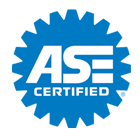Archive for March 2021See the Light (Automatic High Beam Dimmers)Posted March 28, 2021 7:50 AMIt's happened to all of us. We're driving down a highway at night and over a crest appears a car with its high beams blazing. You are momentarily blinded, hoping the other driver will switch them to their low beam setting and restore your vision. Not only do we not appreciate being blinded, face it; we don’t want to be that other driver, either. You know, the one who forgets to turn down their high beams. Why do we want high beams in the first place? They can improve safety when used correctly, giving drivers more reaction time since they can see farther down the road. But research has found many drivers either don't use them or, when they do, they frequently forget to switch to low beams. Enter the automatic high-beam dimmer. The quest for the perfect one began back in the 1950s, General Motors invented something it called the "Autronic Eye." It was a phototube which sat on the dashboard and turned down your beams when it saw other headlights. While touted as being the biggest advance in night driving safety in 30 years, it didn't work all that well. But as technology got more advanced, systems improved. Today's automatic high beam dimmers usually have a camera in the rear view mirror (pointing forward). When the camera sees lights, software in the system's computer attempts to determine the source of the light, whether it is an oncoming vehicle, taillights, ambient city lights, street lights or the reflection off of a street sign. It then adjusts the headlights to operate high beams if appropriate or a less-blinding mode if they’re not. Some automakers are striving to make their headlight systems smarter and safer by developing lamps that can avoid blinding oncoming drivers by means other than simply dimming them. One idea? Splitting the beams so they will block just the portion that shines into the eyes of oncoming drivers. It's a long way from the Autronic Eye. Economy Transmission and Auto Repair Beware Dangers of Spring Driving (Seasonal Driving Tips)Posted March 21, 2021 8:17 AMSure, winter is quickly fading in the rearview mirror, but the peril of icy roads is replaced with a whole new set of driving challenges in spring. Deer and other wildlife. You are not the only one who gets spring fever. Animals do, too, and spring is the time they start looking for mates and food. Be extra careful at dawn and dusk when deer are especially active. Hitting a deer (or having them jump into your path suddenly) is a frightening experience, and even a deer/vehicle collision at slow speeds can cause injury and/or loss of life for both animal and humans, let alone expensive damage to the vehicle. Be extra vigilant during spring. The angle of the light. As the seasons progress, you'll notice sun angles change. The sun is rising earlier every morning and setting later at light. When the sun is low in the sky, that glare can render you almost completely blind. Make sure your windows and windshield are clean; don't forget the inside glass, too, which can build up a haze over the winter. Potholes. The freezing and thawing of pavement is shockingly effective at busting up asphalt and concrete. The holes left behind can seem like moon craters, and if you hit one or more hard, they can cause you to lose control of your vehicle, increasing your chances of an accident. They also can cause some significant damage to your vehicle. If you feel your vehicle pulling to one side, notice it has a rough ride or hear noises you haven’t heard before, have your suspension's integrity inspected at your vehicle service facility. Children playing. Kids are excited to get back outside, running wild, playing with balls and toys… just being kids. These newly-rediscovered outside thrills can also steal away their attention from what's going on around them and they may dart out onto the street before you know it. Spring is a time to be vigilant and devote extra concentration to roads and neighborhoods. Spring is such a breath of fresh air. Remember to be super careful of a whole new set of hazards winter made you forget about for a while.
Got it Covered! (Timing Cover Maintenance)Posted March 14, 2021 9:21 AMYou may have heard at one time or another about something called a timing belt or timing chain in your engine. And you may know that if they fail… well, let's just say that there can be some major engine damage. So obviously, we want our timing belts and chains to be in tip-top shape. One part that helps keep them running the way they should is the timing cover. As you can probably guess, it's something that covers the belt or chain. The timing cover protects both belts and chains from dirt and road debris. Timing belts also need to be lubricated so their covers allow them to be lubricated as well. They have a gasket that insures a good seal for the engine. If that gasket breaks or develops a leak, then engine oil can escape, and loss of lubrication is never good for an engine component. Other symptoms of a failed timing cover are leaking coolant, a metallic sound coming from the front of your engine or your Check Engine light coming on. You might also notice a drop in power when you're going uphill. It's important that your timing cover be in good condition and functioning properly. Your repair facility will check out that part of your engine to make sure gaskets are in good shape and the cover is doing the job it's meant to do. Catch that leaking or broken timing cover in time and your engine will thank you for avoiding some serious damage and an expensive repair. Economy Transmission and Auto Repair How to Radiate Cool (Radiator Care)Posted March 7, 2021 11:10 AMThere's nothing that radiates cool like a vehicle radiator that's helping to keep your engine running at the proper temperature. You don't have to baby it, but you can't simply ignore it, either. Let's take a quick dive under the hood to let you know what the radiator is doing. It takes the heat your engine produces and moves that heat outside. It's not an easy job and heat is an engine's number one enemy. Now that you're thinking how nice you want to be to your radiator, we have a couple of ideas how you can take care of it. The easiest thing is to pay attention to your vehicle's temperature gauge. If it gets in the "too hot" or "not hot enough" range, have it checked out soon. Make sure your coolant is kept at the correct level and if you see a trend that you have to add coolant more than a couple of times a year, you might have a leak. Even if there are no obvious problems, every couple of years or so, consider taking your vehicle in for radiator maintenance. A technician can run a pressure check for leaks and ensure that the thermostat and radiator cap are working correctly. The technician will check that fans are running like they should so they can move air over the radiator and heat away from the coolant inside. Ask your service advisor when you should have your radiator flushed and coolant replaced according to the manufacturer's recommended intervals. In addition to cooling, coolant has corrosion inhibitors which stop working after a while. Without those corrosion inhibitors, the inside of your radiator can literally start rotting away. Keep in mind that the coolant level must be kept at manufacturer's specifications since if those corrosion-preventing chemicals aren't touching the metal, they're not preventing corrosion. Different vehicles use different coolants, so your service facility will make sure yours is getting the correct one. Keep your coolant system happy and one day, maybe you can order up a custom license plate, "RAY-D-8." Economy Transmission and Auto Repair | ||
SearchArchiveFebruary 2010 (2)March 2010 (4) April 2010 (3) May 2010 (4) June 2010 (4) July 2010 (4) August 2010 (4) September 2010 (5) October 2010 (1) November 2010 (5) December 2010 (5) January 2011 (4) February 2011 (4) March 2011 (5) April 2011 (4) May 2011 (4) June 2011 (5) July 2011 (4) August 2011 (21) September 2011 (4) October 2011 (4) November 2011 (5) December 2011 (4) January 2012 (5) February 2012 (4) March 2012 (4) April 2012 (4) May 2012 (2) June 2012 (3) July 2012 (1) August 2012 (1) November 2012 (1) December 2012 (2) March 2013 (1) April 2013 (3) May 2013 (2) October 2013 (5) November 2013 (2) January 2014 (2) February 2014 (3) March 2014 (2) July 2014 (3) August 2014 (7) September 2014 (4) October 2014 (5) November 2014 (4) December 2014 (4) January 2015 (5) February 2015 (4) March 2015 (4) April 2015 (5) May 2015 (2) June 2015 (6) July 2015 (2) September 2015 (2) October 2015 (5) November 2015 (3) December 2015 (3) February 2016 (1) March 2016 (5) April 2016 (4) May 2016 (5) June 2016 (4) July 2016 (5) August 2016 (4) September 2016 (4) October 2016 (5) November 2016 (4) December 2016 (4) January 2017 (5) February 2017 (4) March 2017 (4) April 2017 (4) May 2017 (4) June 2017 (5) July 2017 (5) August 2017 (4) September 2017 (3) October 2017 (5) November 2017 (4) December 2017 (3) January 2018 (5) February 2018 (4) March 2018 (4) April 2018 (5) May 2018 (4) June 2018 (4) July 2018 (5) August 2018 (4) September 2018 (5) October 2018 (4) November 2018 (4) December 2018 (5) January 2019 (4) March 2019 (4) May 2019 (2) June 2019 (5) July 2019 (2) August 2019 (2) September 2019 (4) October 2019 (5) November 2019 (4) December 2019 (5) January 2020 (5) February 2020 (4) March 2020 (5) April 2020 (1) May 2020 (2) July 2020 (2) August 2020 (5) September 2020 (4) October 2020 (4) November 2020 (5) December 2020 (4) January 2021 (6) February 2021 (4) March 2021 (4) April 2021 (4) May 2021 (5) June 2021 (4) July 2021 (4) August 2021 (5) September 2021 (4) October 2021 (5) November 2021 (4) December 2021 (4) January 2022 (6) February 2022 (4) March 2022 (4) April 2022 (4) May 2022 (5) June 2022 (4) July 2022 (3) September 2022 (4) October 2022 (5) November 2022 (4) December 2022 (4) January 2023 (5) February 2023 (4) March 2023 (4) April 2023 (5) May 2023 (4) June 2023 (4) July 2023 (5) August 2023 (4) September 2023 (4) October 2023 (1) January 2024 (1) February 2024 (4) March 2024 (1) | CategoriesAir Conditioning (17)Alignment (17)Alternator (6)Auto Safety (6)Automotive News (8)Battery (20)Brake Service (4)Brakes (22)Cabin Air Filter (8)Check Engine Light (6)Cooling System (19)Customer Detective Work (1)Dashboard (3)Diagnostics (5)Diesel Maintenance (1)Differential Service (4)Drive Train (9)Emergency Items (1)Engine Air Filter (2)Exhaust (12)Fluids (17)Fuel Economy (10)Fuel Pump (1)Fuel Saving Tip: Slow Down (2)Fuel System (47)Headlamps (6)Inspection (11)Keys to a long lasting vehicle (4)Maintenance (53)Monitoring System (3)Oil Change (7)Older Vehicles (4)Parts (7)PCV Valve (2)Safe Driving (1)Safety (6)Serpentine Belt (6)Service Intervals (9)Service Standards (13)Shocks & Struts (9)Shocks and Struts (1)Spark Plugs (2)Steering (15)Suspension (3)Timing Belt (6)Tire Rotation and Balancing (3)Tires (10)Tires and Wheels (40)TPMS (3)Transfer Case Service (1)Transmission (11)Trip Inspection (4)Warranty (2)Water Pump (1)What Customers Should Know (81)Wheel Bearings (1)Windshield Wipers (9)Winter Prep (7)Winter Tires (1) | |








